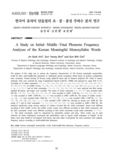The purpose of this study was to analyse the frequency characteristics of 583 Korean meaningful monosyllabic
words by their initial·middle·final phonemes to understand speech recognition ability based on hearing configuration
more accurately. Normal hearing 20 Korean young adults(10 males and 10 females) produced 583 words in context
situations. Data were collected by using Computerized Speech Lab(CSL 4300B) and analyzed by using Pratt 4.3.14.
According to 19 initial consonants, /ㄱ/, /ㄴ/, /ㄷ/, /ㄹ/, /ㅁ/, /ㅂ/, /ㅅ/, /ㅇ/, /ㅈ/, /ㅊ/, /ㅋ/, /ㅌ/, /ㅍ/, /ㅎ/, /ㄲ/, /
ㄸ/, /ㅃ/, /ㅆ/, /ㅉ/, 18 middle vowels, /ㅏ/, /ㅐ/, /ㅑ/, /ㅓ/, /ㅔ/, /ㅕ/, /ㅖ/, /ㅗ/, /ㅘ/, /ㅙ/, /ㅚ/, /ㅛ/, /ㅜ/, /ㅝ/, /ㅟ
/, /ㅠ/, /ㅡ/, /ㅣ/, 7 and no final consonants, /ㄱ/, /ㄴ/, /ㄷ/, /ㄹ/, /ㅁ/, /ㅂ/, /ㅇ/ were analyzed and their means,
standard deviations, and ranges were recorded. The means of initial consonants /ㄴ/, /ㄹ/, /ㅁ/ were recorded under
500 Hz, /ㄱ/, /ㄲ/, /ㅂ/, /ㅃ/, /ㅇ/, /ㅋ/, /ㅍ/, /ㅎ/ were recorded at 1,000 ~ 2,500 Hz, /ㄷ/, /ㄸ/, /ㅈ/, /ㅉ/, /ㅊ/, /
ㅌ/ were recorded at 4,000 ~ 5,000 Hz, /ㅅ/, /ㅆ/ were recorded at 5,000 ~ 6,000 Hz. The means of middle vowels /
ㅛ/, /ㅝ/, /ㅠ/ were recorded under 1,000 Hz, /ㅑ/, /ㅕ/, /ㅖ/, /ㅗ/, /ㅜ/ were recorded 1,000 ~ 2,500 Hz, /ㅏ/, /ㅐ/,
/ㅓ/, /ㅔ/, /ㅘ/, /ㅙ/, /ㅚ/, /ㅟ/, /ㅡ/, /ㅣ/ were recorded 2,500 ~ 4,000 Hz, showing no means over 4,000 Hz. The
means of 7 and no final consonants /ㄱ/, /ㄴ/, /ㄷ/, /ㄹ/, /ㅁ/, /ㅂ/, /ㅇ/ were recorded at 2,000 ~ 3,000 Hz. The
statistical significance using oneway analysis of variance revealed that the initial consonants’ means were different
according to their middle vowels, the middle vowels’ means were different according to their initial consonants, and
the final consonants’ means were different according to their initial consonants except initial consonants /ㄴ/, /ㄹ/, /
ㅁ/. The initial consonants could be categorized by articulation manner and place. These results can be used
clinically for better audiological assessment and rehabilitation such as speech sound audiogram of English. In the
future, more data should be investigated with female and male talker vocalizations for more systematic and complete
frequency analysis according to initial·middle·final phonemes.

